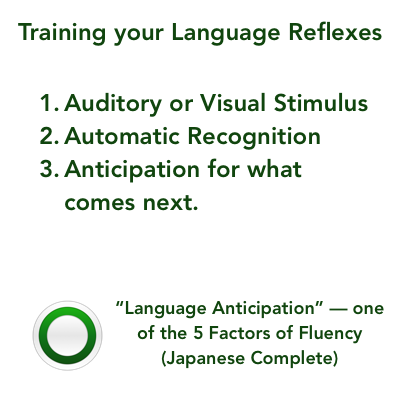
This article is about training your language reflexes for any target language you wish to master. We specialize in Japanese education but the principles here are applicable to any language you wish to become highly effective in and master.
Announcement: Free Starter Accounts are now available for Japanese Complete. You can access the first three chapters of our online Japanese curriculum, including audio, visuals, and quizzes, by registering here.
Training your Language Reflexes
Let’s start with a concrete example.
When you hear the phrase “He said…” or “She said…” you know without thinking that what follows will be a quotation.
How did you figure this out? You don’t have to look it up in a dictionary every time.
It is fair to say that one’s comprehension is automatic. There is the auditory or visual stimulus, the automatic recognition of that stimulus, and anticipation for what comes next.

To get to a highly effective, near-native level in any target language, including Japanese, it is important to have trained your language reflex(es), such that stock phrases and constructions are automatic.
SVO and SOV
SVO is Subject then Verb then Object.
SOV is Subject, then Object, then Verb at the end.
English is an SVO language. “He kicks the ball.” “She runs to the store.” In both cases, the subject comes first, then the verb or action, and finally the target.
Languages that match the SVO pattern are easier to master swiftly when your native language is also SVO. So, English to German, English to French, English to Spanish, all these will have the same standard sentence structure when we strip away the frills.
If your native tongue is Korean or Japanese, however, you are coming from a world of SOV, where the verb always comes at the end. Some sentences are just a verb and that is perfectly natural (aside: I suppose you can simply say “Runs.” or “Climbs.” in the style of Hemingway but it is usually still preceded by a subject, “She runs.” “He climbed.”)
So likewise, when a person is starting from Japanese, they can more easily acquire Korean grammar because they match on this basic level of SOV, Subject then Object, then Verb.
When one’s target language differs in this fundamental pattern from their native tongue, there is a level of retraining required to engender the appropriate reflex. A mouthful to say, you gotta retrain your brain.
Two Different Ways to Retrain Your Brain
Most language learners of the previous hundred years would state that rote memorization and repetition are the keys to language adroitness. That is one way to do it, but it’s certainly not the only way. The brain is most friendly to associations we create and nurture, through repeated exposure or through conscious effort. While rote memorization is more of a passive-association activity, conscious effort can be a swift shortcut to the same results.
In short, there is the rote approach, and the conscious approach. Putting your mental sensorium into the context and having it stick gradually and passively, or putting your mind on it actively and creating excess connections and associations to eventually walk away with the wheat separated from the chaff.
Creating Cross-Lingual Bridges
Part of fluency is not only the ability to recall expressions and labels, but also the ability to cross-linguistically equivocate them.
Example: An apple is a りんご [ringo, Japanese] is a تفاحة [tufa’a, Arabic].
When one is able to access equally or near-equally the variety of language constructs from different tongues, one is, more-or-less, fluent in their ability to express themselves cross-linguistically.
How to Retrain Your Brain
For labels (nouns: people, places, things) the process is simple enough: take a vocabulary list, envision in your mind’s eye the object you are learning alternate names for, and say out loud the new name. A flower is はな [hana] in Japanese. So bring to mind a bouquet or a field of flowers, and repeat to yourself “hana.” You might even want to put the new label into a native-language context: There is a beautiful field of はな [hana] blooming right now in the Spring.
For expressions and more subtle language constructs, the process is similar: create the anticipation in your mind that you experience in your native tongue, and equate that feeling or sense with the expression you are learning.
Vocabulary List
はな [hana] flower
えんぴつ [empitsu] pencil
For example, when learning the Japanese particle は [wa] we can remember the English phrase “Speaking of blank.” Now when you say えんぴつは [empitsu wa] you are saying “Speaking of the pencil…” or “As for the pencil…”
Grammar List
Topic + は [wa]
As for Topic…,
Speaking of Topic…
What about the pencil? Is it blue? Is it green? Is it long? Is it short? Is it lost? Is it heavy? Is it comfortable to hold? The particle は [wa] in Japanese lines up your language anticipation or language reflex to have a very open-minded way to resolve the gap in the harmony of the phrase. It’s just as if we are listening to a symphony with a tense, color note shading the sound field and finally, we hear a major chord at the end to resolve the tension. This anticipation or this feeling of tension is there, before we have the total explanation, and equating one’s inner sense with various expressions and phrases will help one become highly effective and attain near-native fluency, rapidly.
Summary
Leverage your native language as well as your natural language cliff-hanging reflex for tension and yet-to-be-resolved statements to get an intuitive and visceral grasp of your target language. Then, you can be highly effective and natural in your target language very quickly.
How Does Japanese Complete do this?
We have developed a collection of thorough grammatical explanations, accompanied by helpful visuals and fun quizzes to help train the language anticipation and “fill-in-the-blank” feeling required to attain near-native fluency, rapidly. We leverage your native language (namely, English) to create nuanced associations in the minds of our learners, so they have a proper reflex for the expressions of the target language.
These ideas can be successfully exported to other languages and even other domains of study. The key point is making things relevant to something already existing in your life and experience. Rather than starting from zero like a baby and absorbing the world for years like a sponge before vocalizing anything, as a teenager and adult we already have a place for these feelings and associations, we simply need to bring them to mind as we study and create the associations so that they become second-nature. As one Daoist teacher recently stated, “First you build the bridge brick by brick, and eventually you are walking the invisible bridge that takes you across the chasm effortlessly.”
Thanks for reading and happy language learning! If you want to start mastering Japanese, we are happy to announce the addition of Starter Accounts to Japanese Complete that are absolutely free and ad-free.
